|
A few months ago, rumors were circulating that
Ruger
was working on something very different for them. Last year, at
the 2008 SHOT Show in
Las Vegas, they entered the pocket pistol market in a big way,
and the .380 LCP auto was an
overwhelming success. Ruger has sold many thousands of the
little pistols, and the demand is still high. This
year at SHOT in Orlando, which opens tomorrow (January
15, 2009), Ruger will again be the talk of the industry with
their new LCR .38 Special Plus P five-shot pocket revolver.
The lightweight five-shot revolver market is very popular, and
Ruger is set to take a huge chunk of that market for themselves.
Ruger has produced quality revolvers for decades, and their SP101
compact revolvers are very popular, but most find them
too heavy for pocket carry. More citizens everyday are choosing
to go heeled in our society, and lightweight revolvers are very
popular among those who carry concealed. With the LCR, Ruger is
aiming straight at the Smith & Wesson J-frame buyer,
not with a copy of that design at all, but with a revolver that
is a radical departure from conventional revolver design. The
frame of the LCR is made up of two components. The cylinder
frame is made of aluminum, which is a pretty conventional
material for a lightweight pocket gun. However, the grip frame
is made of a high-tech polymer, and extends below and to the
rear of the cylinder frame, cradling that unit, and contains all
of the fire control parts, such as the hammer, sear, and
trigger, along with the necessary springs and pins to contain
and provide fulcrums for those moving parts. The cylinder and
internal parts are made of stainless steel. The polymer grip
frame is not a stressed part. It comes out of the mold ready to
assemble, and requires no hand fitting to the cylinder frame nor
to the internal parts.
Back in
early December, I was invited to the Ruger factory in New
Hampshire to have a look at the LCR. While there, I saw
some other very interesting future Ruger projects, but for now,
we are looking at the LCR. I gave my word and have been sworn to
secrecy until today, the day before SHOT, to keep quiet about
the LCR. Today is the day that Ruger is introducing the LCR to
the outdoor media, and this is the day that I have permission to
tell you about this little revolver. I got to shoot the LCR at
the factory, and I was expecting to have a gun in for a full
review by now, but it has yet to arrive, so I have to go with
what I have. Ruger has put a lot of time and money into the
design of the LCR, particularly the geometry of the internal
parts. Judging from my shooting experience at the factory, they
got it right. The trigger pull on the LCR is very smooth, and
very light for a pocket revolver. Many pocket revolvers have
dreadful trigger pulls, and I get a lot of email from readers
who buy a gun for defense, and have a very hard time pulling the
trigger. If the production LCRs are like the one that I shot,
the trigger pull problem is solved. That gun had what could be
called a perfect trigger pull for a pocket revolver; a smooth
and light double action. I do not know the pull weight of the
LCR, but will measure such things when a production gun arrives.
Accuracy was also very good. The sights are easy
to see in good light, but in the Ruger indoor range, I had
trouble seeing them against the target that we had. Many of you
donít know it, but I do not see nearly as well as I once did,
and in certain conditions, I just cannot see black sights
anymore. Thankfully, Ruger is also offering the LCR with a Crimson
Trace Lasergrip, and CT was in on this early. The grip of
the LCR was designed to take a Lasergrip from the start.
Attaching a Lasergrip to the LCR, I was able to punch tight
groups on the target, greatly improving my accuracy with the
little gun. There were five of us there shooting the LCR, and
the Lasergrip improved the practical accuracy of the gun for all
of us, even the youngest shooter who still has good eyesight, Eric
Poole of Harris Tactical Group. Recoil from the
thirteen ounce revolver was easy to handle, maybe due in part to
the polymer frame, or maybe just the design of the angles and
such. I donít know, and wonít know until I can get a test
gun in here for a full evaluation.
Anyway, for now, this is enough information to
pique your interest, if you are interested in pocket guns and
revolver design at all. This is certainly something different,
and should be the talk of SHOT this year. I am always interested
in new firearms design, and so far, I really like this little
gem. Whether or not it will replace the J-frame in my pocket
remains to be seen, but I am anxious for some more trigger time
behind this little LCR.
Check out the full line of Ruger products
here.
For the location of a Ruger dealer near you,
click on the DEALER FINDER at www.lipseys.com.
Look for a full review of the new LCR soon right
here on Gunblast.com.
Jeff
Quinn
|
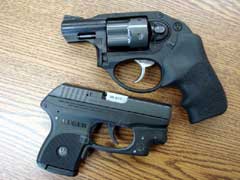
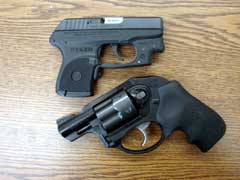
The LCR compared to Ruger's LCP .380 pistol.
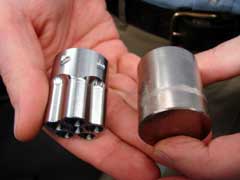
LCR cylinder is CNC machined from solid bar stock.
|
  
Got something to say about this article? Want to agree (or
disagree) with it? Click the following link to go to the GUNBlast Feedback Page.
|
|
Click pictures for a larger version.
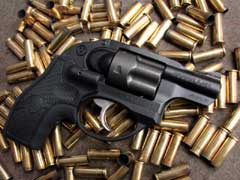
Ruger's new LCR revolver.
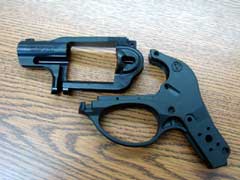
Separate grip frame & cylinder frame.
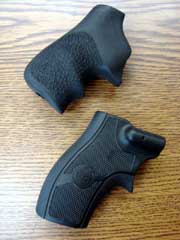
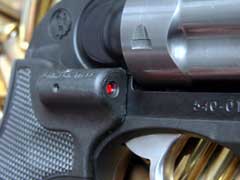
Standard grip compared to optional Crimson Trace
lasergrip.
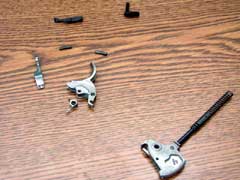
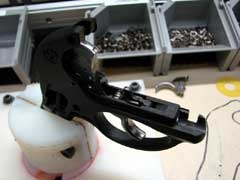
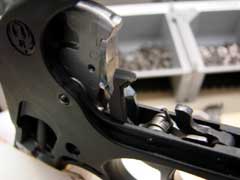
Trigger and hammer components are all contained within
the polymer grip frame.
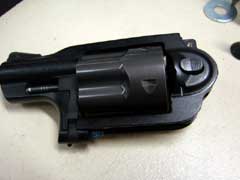
Aluminum cylinder frame.

|
![]()